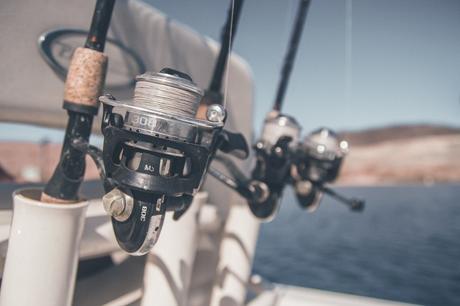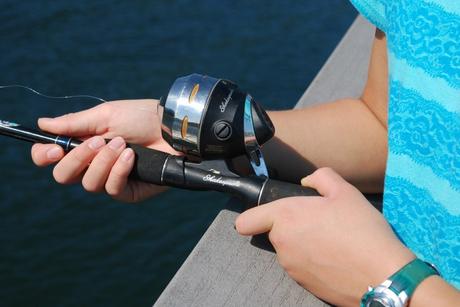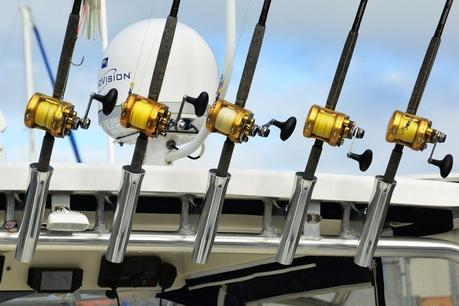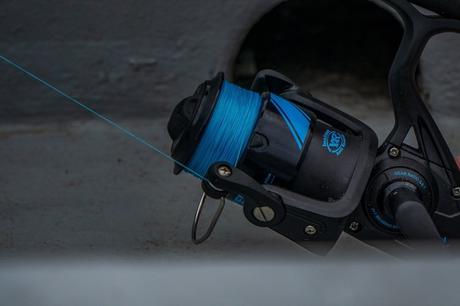Original Article: Different Types of Fishing Reels – Explained

Article by: Tiago Lopes
Unless you’re out spearfishing, using a net, a pole without a reel, or using your bare hands, you’re most likely going to be fishing using the most common method: A fishing pole with a fishing reel attached.
Fishing reels serve the very important purpose of holding the fishing line and allowing it to be reeled out and in to move the bait and reel in the fish once it is caught. They are also a very old, and therefore developed invention. Having been around for almost 1000 years, they have evolved to come in many different forms with many different features. However despite their ancient nature, for modern fishing, they need to be strong, well-manufactured, and effective at their task.
The most common types of fishing reels will be covered in this article, specifically the Spincast Reel, Baitcast Reel, Spinning Reel, and Fly Reel. Each has its own advantages and disadvantages that are important to be familiar with, as well as unique features and abilities that will result in the best choice option for different types of fishing.
Spincast Reel

The Spincast Reel was introduced with the intent of solving many common problems found with fishing reels, such as twisting lines that occur in other common designs. It ended up being a very effective and easy to use solution that is light, great for beginners, cheap, and durable.
The Spincast Reel is mounted above the fishing pole and is generally smaller than most reels. It is covered by a plastic cone that keeps the reel in place and is operated by pressing a button which releases the hold on the line. The line can then be thrown like in any normal fishing reel and reeled back in by spinning the handle.
Due to its design and features, it is appropriate for many beginners in the sport of fishing. Since the design is typically small, the line will not extend far and is limited to smaller areas and less intense fishing. Additionally, the spool is slightly less strong to do the design which allows for ease of use, however, this limits its application to smaller types of fish. As a result, for entry-level fishers who want to start off small in freshwater areas and catching smaller fish, the Spincast Reel is ideal. This is especially true due to its lower cost, smaller size, and portable nature.
PROS
As mentioned, the primary benefit of the Spincast Reel is the intended purpose of its design. It is inexpensive and ideal for beginners. It is also incredibly easy to use, with the simple push-button taking care of the majority of the complex operation, and is reliable in that it should never give you trouble with twisted lines or trouble inducing snares. As a result, it is very appropriate for freshwater fishing and the catching of smaller fish – which is exactly where a beginner would be looking to fish.
In other words, the Spincast Reel is:
- Cheap
- Reliable
- Easy to Use
- Great for beginners
CONS
Unfortunately, the very benefits of the Spincast Reel spell out its drawbacks. Due to its inexpensive and easy to use design, it will simply never be appropriate for sport fishing, open water, or saltwater fishing. It is also only going to work for very small fish and therefore has limited use. Although the price is low, you will soon be looking to upgrade if you have recently purchased a Spincast Reel and feel comfortable with it.
In other words, the Spincast Reel is:
- Only useful in freshwater
- Only good for smaller fish
Baitcast Reel

The Baitcast Reel attempts to solve many of the common issues that occur with most reels, which likens it to the Spincast Reel in this way. However, it does so at a slightly more advanced and reliable method that increases quality and creates a better reel. The primary difference here is that the Baitcast Reel’s spool spins as the line is cast out, whereas the Spincast does not. This also results in the Baitcast being a multiplying reel, meaning each rotation releases a larger amount of line. This additional spinning decreases line twisting and makes the Baitcast incredibly reliable.
Due to this design, the Baitcast Reel can also cast to greater distances and with more accuracy. It also comes in more available sizes which increases the diversity of its application. It can, therefore, be used in freshwater areas, open water areas, or salt water and with a far greater variety of fish. Its main challenge being that due to its slightly more advanced operation, it can be difficult to master and should be used mostly by more advanced anglers.
When looking for a Baitcast Reel, keep an eye out for the spool being mounted uniquely on top of the fishing rod, with a double-sided handle that is attached to an open spool.
PROS
Although at first it may seem as though the benefits of the Baitcast Reel are not much greater than that of the Spincast in that it is reliable and prevents line twist, its advantages actually extend far beyond these simple functions. Specifically, the Baitcast Reel can launch the line further and with greater accuracy while still maintaining the reliability found in other different types of fishing reels.
If this sounds like the reel for you, check out our list of the best baitcaster combos.
- Reliable
- Casts further
- Casts more accurately
CONS
Unfortunately, the amazing benefits of the Baitcast Reel come at a cost when compared to other different types of fishing reels. Most notably, due to the specific design which allows for a multiplying spool that releases a larger amount of line, this reel is slightly more difficult to operate and requires a little bit of training and experience. For this reason, it is more suitable for more advanced and experienced anglers. It also generally runs at a higher cost than other reels, so investment in a Baitcast Reel should come only for those who are more serious about the sport of fishing.
- Difficult to master
- More expensive
Spinning Reel

The Spinning Reel is by far the most common and popular type of fishing reel available and in general, it is what likely comes to mind when people think of fishing reels. It is characterized by being located on the side of the fishing rod, with an enclosed spool that actually does not rotate. Instead, the handle physically wraps the line around the spool. As a result, the Spinning Reel is easy to operate, versatile, and in general affordable.
Alongside the Spincast Reel, the Spinning Reel is generally the most recommended type of fishing reel for beginners. Its lower number of moving parts allows the entire assembly to be easier to comprehend and therefore use effectively. The only major trouble one might encounter when using this type of fishing reel is that occasionally the line will not properly wrap around the spool. Therefore, it is important to pay attention when beginning to reel it in so that the line does not twist. Since it can still fish in both freshwater and saltwater areas, the Spinning Reel is still generally recommended for beginners despite the need to be wary of potential line twisting during its use.
PROS
Due to its versatile design and reliable nature, it is hard not to list the long list of pros provided by the Spinning Reel. It is no wonder anglers worldwide often chose this type of reel as a preference when fishing whether at a beginner or advanced level. The following pros most clearly encompass the vast benefits provided by the Spinning Reel:
- Great for beginners
- Usable in fresh or saltwater
- Cheap
- Many different options
CONS
Unfortunately, every great thing also comes at a price. In the case of the Spinning Reel, the price is in the larger potential for line twisting. In comparison to the Spincast Reel, which solves this problem but sacrifices the long-range and versatility, the Spinning Reel can cast long-range and accurately by sacrificing the ability to prevent line twisting. As a result, although it is generally still recommended for beginners, it does in fact still have a slightly steeper learning curve. Those who are brand new to angling may want to seek out a friend or instructor when starting out with a Spinning Reel. The following summarizes the cons of this type of fishing reel:
- Occasional line twisting
- Slight learning curve
Fly Reel

The Fly Reel is unique when compared to other different types of fishing reels in both its design and its general application. In commonality with its name, the Fly Reel is usually used for fly fishing. This is as a result of its ability to cast very light baits very effectively such as flies. However, the difference here lies not only in the reel design, but in the line as well. The line is thicker and stronger which allows it to maintain strength when being cast despite a virtually weightless bait. To cast this thicker line, the reel consists of a simple spool that rotates around a central pin.
Despite its simple design and application, Fly Reels are also capable of coming in various different designs and forms. Each have their own advantages and disadvantages. Specifically, they will come in different sizes that allow you to attempt to angle different sizes of fish. For instance, a smaller Trout might not require as large of a spool as a big brown. Nowadays, Fly Reels have evolved to have drag systems, and to be able to be used in both fresh and saltwater areas, making them the ideal choice for anybody trying their hand at fly fishing.
PROS
As mentioned, the primary benefit of a Fly Reel when compared to other different types of fishing reels is in its application. It is the only type of fishing reel that can be effectively applied towards fly fishing, where the bait is virtually weightless. It does so using a thicker line, and its design has today evolved to an advanced point that makes it very versatile with many different ideal options for this type of fishing.
- Ideal for fly fishing
- Versatile
CONS
Similar to the mentioned pros, the main disadvantage of the Fly Reel is its limited application. If investing in a Fly Reel, be aware that it will not be very effective at any other type of angling since the line is too thick and will not be able to be cast very far or precisely with a heavier type of bait. Therefore, be very aware of this factor. Regarding cost, the Fly Reel can have a broad range due to the developed versatility in the modern age of fishing. Simpler older types of fly reels can be very affordable but will lack many of the features of more expensive alternatives such as drag reduction.
- Limited application
- Undefined range of cost
Conclusion
Overall, the different types of fishing reels covered only encompass the broad range of the most common types of reels. Whereas the Spinning Reel is the most common, it can be replaced by a Spincast Reel for those seeking an even cheaper and easier to use alternative. However, the Spincast Reel will be limited to small distances and freshwater areas. For more advanced anglers trying their hand at open saltwater fishing or sportfishing, the Baitcast Reel is the ideal choice as it offers long-range and accuracy – at a price. Lastly, the Fly Reel is reserved specifically for those looking to fly fish, whether in fresh or saltwater areas.
In general, the decision of which type of fishing reel to purchase is ultimately up to the individual. We hope to have provided readers with a general outline that can help educate anybody looking to either get into the sport of fishing or advance to a different level by purchasing a unique type of reel. Of course, it is important to be aware of price when making this decision, but being able to accurately weigh the pros and cons of each type of reel can be very beneficial when evaluating what appears simple, but can in fact be a slightly confusing topic in fishing.
